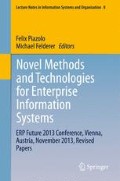Abstract
The decomposition of business processes and related artifacts is a necessary concept in conceptual modeling as well as in the definition of executable workflows. Decomposition is supported by almost all business process modeling notations and execution engines. Thereby the design of the interfaces and the semantics of these are an important factor to concern with impact, e.g., on a common understanding of the involved stakeholders. In this paper we analyze the flexibility and expressiveness of business process specifications with respect to hierarchical structure in a modeling language independent manner. The semantics of how instances of process capsules are initially and intermediately triggered via their interfaces turns out to be crucial for the discussion. We aim at clarifying the situation by characterizing and comparing a kind of intensional, so-called open, and a kind of extensional, so-called closed semantics for business process capsules.
Access this chapter
Tax calculation will be finalised at checkout
Purchases are for personal use only
References
Atkinson, C., Draheim, D., & Geist, V. (2010). Typed business process specification: Proceedings of EDOC 2010—The 14th IEEE International Enterprise Distributed Object Computing Conference, IEEE Press.
Balabko, P., Wegmann, A., Ruppen, A., & Clement, N. (2005). Capturing design rationale with functional decomposition of roles in business processes modeling. Software Process—Improvement and Practice, 10(4), 379–392.
Böhm, C., & Jacopini, G. (1966). Flow diagrams, turing machines and languages with only two formation rules. Communications of the ACM, 3(5), 366–371.
Auer, D., Geist, V., & Draheim, D. (2009). Extending BPMN with submit/response-style user interaction modeling. In B. Hofreiter & H. Werthner (Eds.), Proceedings of CEC’09—The 11th IEEE Conference on Commerce and Enterprise Computing, IEEE Press.
DeMarco, T. (1979). Structured analysis and system specification. Englewood Cliffs: Prentice Hall.
Draheim, D. (2010). Business process technology—A unified view on business processes, workflows and enterprise applications. Berlin: Springer.
Draheim, D. (2009). Frontiers of structured business process modeling. In A. Hameurlain, J. Küng & R. Wagner (Eds.), Transactions on large scale data- and knowledge-centered systems I. Springer.
Draheim, D., & Weber, G. (2004). Form-oriented analysis—A new methodology to model form-based applications. Springer. Decomposition of Business Process Models 15.
Eshuis, R., & Wieringa, R. (2001). A formal semantics for UML activity diagrams—Formalising workflow models. Technical Report CTIT-01-04, University of Twente, Department of Computer Science.
International Organization for Standardization (2008). International Standard ISO/IEC 38500:2008. Corporate governance of information technology. ISO.
Johannsen, F., & Leist, S. (2012). Wand and Weber’s decomposition model in the context of business process modeling. Business & Information Systems Engineering, 4(5), 271–286.
Milani, F., Dumas, M., & Matulevicius, R. (2013). Decomposition driven consolidation of process models: Proceedings of CAiSE’2013—The 25th International Conference on Advanced Information Systems Engineering, LNCS, Springer.
Central Computer and Telecommunications Agency. (2000). IT infrastructure library—Service support. Renouf.
Office of Government Commerce (2002). ICT infrastructure management. Bernan.
Jalloul, G. (2004). UML by example. Cambridge: Cambridge University Press.
Rao Kosaraju, S. (1973). Analysis of structured programs: Proceedings of the 5th Annual ACM Symposium on Theory of Computing, pp. 240–252.
National Institute of Standards and Technology (1993). Integrated definition for functional modeling (IDEF0). Draft Federal Information Processing Standards Publication 183. U.S. Department of Commerce.
Object Management Group (2006). Business process modeling notation (BPMN) specification. Final Adopted Specification, dtc/06-02-01.
Reichert, M., & Weber, B. (2012). Enabling flexibility in process-aware information systems—Challenges, methods, technologies. Springer.
Romero, H., Dijkman, R., Grefen, P., van Weele, A. (2012). Harmonization of business process models: Proceedings Business Process Management Workshops, LNBIP 99, Springer.
Ross, D. T., & Brackett, J. W. (1976). An approach to structured analysis. Computer Decisions, 8(9), 40–44.
Schäfermeyer, M., Rosenkranz, C., & Holten, R. (2012). The impact of business process complexity on business process standardization—An empirical study. Business & Information Systems Engineering, 4(5), 261–270.
Scheer, A. -W. (1999). ARIS—Business process modeling. Heidelberg: Springer.
Scheer, A. -W., Thomas, O., Adam, O. (2005). Process modeling using event-driven process chains. In M. Dumas, W. M. P. van der Aalst & A. H. M. ter Hofstede (Eds.), Process-aware information systems—Bridging people and software through process technology (pp. 119–146). Hoboken: Wiley.
Wand, Y., & Weber, R. (1991). A unified model of software and data decomposition: Proceedings of ICIS’91—The 12th International Conference on Information Systems, University of Minnesota Minneapolis.
Workflow Management Coalition (1999). Workflow management coalition terminology & glossary. Document Number WFMC-TC-1011, WfMC.
Author information
Authors and Affiliations
Corresponding author
Editor information
Editors and Affiliations
Rights and permissions
Copyright information
© 2014 Springer International Publishing Switzerland
About this paper
Cite this paper
Draheim, D. (2014). On the Trade-Off Between Flexibility and Extensionality in the Decomposition of Business Process Models. In: Piazolo, F., Felderer, M. (eds) Novel Methods and Technologies for Enterprise Information Systems. Lecture Notes in Information Systems and Organisation, vol 8. Springer, Cham. https://doi.org/10.1007/978-3-319-07055-1_7
Download citation
DOI: https://doi.org/10.1007/978-3-319-07055-1_7
Published:
Publisher Name: Springer, Cham
Print ISBN: 978-3-319-07054-4
Online ISBN: 978-3-319-07055-1
eBook Packages: Business and EconomicsBusiness and Management (R0)

